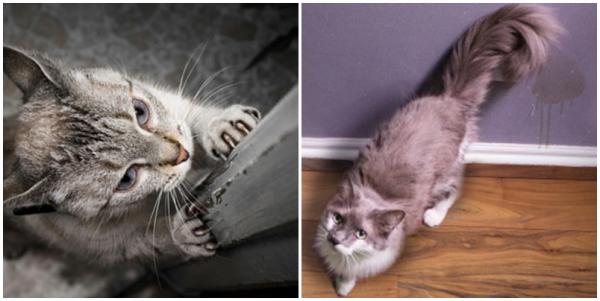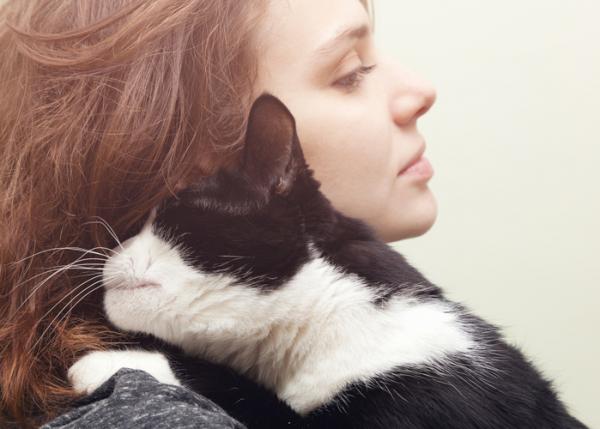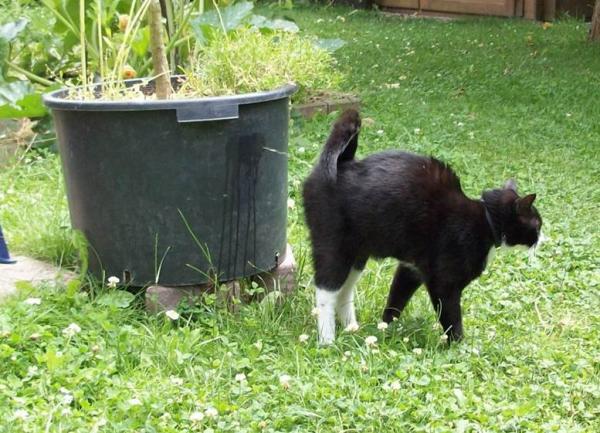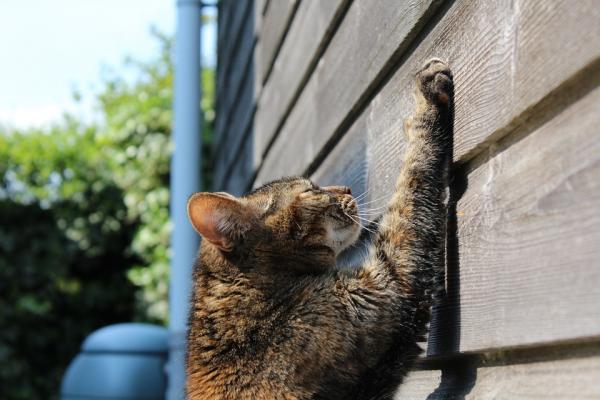My sterilized cat keeps checking

There is no doubt that cats are great companions: elegant, playful and intelligent. However, sometimes, situations can occur that disconcert us and break the harmony in our coexistence with our feline friends. One of these situations that can dislocate us and annoy us is the marking inside the house.
First of all, you may wonder why cats have the need to mark, even when sterilized. Well, this behavior is because cats are very territorial animals, because despite being predators, they are also vulnerable to other animals or possible “intruders” of their own species, leaving olfactory and visual marks, delimiting their territory and they create a safe area in which they feel safe. They also provide information about their age, sex, state of health, time of the reproductive cycle, etc. Keep reading in to know some practical solutions when a sterilized cat keeps checking.
If I sterilize my cat, will it stop marking?
There three forms of marking on cats: facial, with urine, and with nails.
Sterilization usually corrects between an 53% and an 78% of the cases of urine labeling in males [1]. In females, if it is due to marking by heat, it usually disappears completely, not disappearing if the underlying cause is another.
El facial marking and with the nails, do not respond to sterilization. All these data must be taken into account when deciding whether or not to sterilize our cat and clarify all the doubts about our veterinarian, setting realistic expectations of what castration entails.
Then we will review in detail the three types of marking with some more detail and some tips to avoid them as much as possible when they pose a problem.
1. Facial marking
Consists in rub the sides of the cuello with vertical objects or with other animals or people. This behavior leaves a olfactory brand that the cat considers as its safe area and helps reduce the stress associated with the changes. It is usually a sign that you are comfortable and that you are “at home”. Normally it does not cause rejection in the owner, on the contrary, it is a sign of affection and trust.

2. Marking with urine
It is undoubtedly the one that most often worries the owners and even occasionally, is a reason for consultation and abandonment in the worst case. To begin with, it is very important to know how to differentiate when our cat has a behavior of marking and when is it due to a pathological process.
When a cat marks with urine, it performs spray micturition on vertical surfaces, lifting the tail. He usually makes them all over the house and continues defecating inside the sandbox or outside if he goes outside the house (marking with feces is very rare). When the cat is whole (uncastrated), the marking is much more frequent and the smell of urine much stronger, due to the presence in large quantity of a substance called felinin.
In cases of enfermedades of the urinary tract (the most common is cystitis or inflammation of the bladder), urination is usually on horizontal surfaces and the animal usually does a small amount and often (dysuria), even showing signs of pain (stranguria) and, in Sometimes, urinate with blood (hematuria). In cases of aversion to the sand tray, usually urinate near the same but outside and in normal amount, and often defecate also outside.
If we suspect that the behavior that shows may be due to a health problem, it is important contact the veterinarian to explore it. Especially in males, it can be serious and must act fast (also, in sterilized and overweight cats it is more common to have problems in the lower urinary tract).
When the marking persists after castration, it is usually related to stress problems, being more common in multigato houses. Also, diseases of the lower urinary tract may be due to infectious causes, but most are also triggered by situations of chronic stress.
Therefore, The advices that we will give you, above all, aimed at minimizing stress in our cats:
- Environmental enrichment: it is important especially in cats indoor, and it goes from spending time playing with them, providing them with appropriate toys, high places from which they can control their territory, platforms near the windows so that they can look outwards, resting places and enough feeding places for all the cats of the house, water sources or places to hide if they need it.
- Toilet area: the sand tray is recommended to be away from the area where the cat rests and eats. We must be careful with hygiene and avoid changing frequently the type of substrate and type of tray. It must be large enough so that the cat can turn on itself and there should be a ratio of trays of n + 1 with respect to the number of cats we have. We should also try to place them in a quiet area and, if possible, not be a usual passage area.
- Cleaning of the marked area: it is recommended to clean the area with an enzymatic detergent and once it is clean, dry it thoroughly and wipe it with surgical alcohol. Finally, it is very useful to use synthetic feline pacifying pheromone spray, spraying it above the marked surface. In this way, the cat will consider that it has marked that place and will not urinate in it again. We will avoid the use of cleaning products with strong odors such as bleach or ammonia.
- NEVER we must quarrel, much less attack our animal for having urinated. They do not do it as revenge but as a way to manage the anxiety they suffer and if we act aggressively we would only make the situation worse.
- If we foresee that there will be a major change at home: the arrival of a new animal, a baby, reforms, removals, etc., we should try to make this change as gradual as possible and we can help again the use of synthetic pheromones, either in spray or diffuser for the cat feel that it is still his territory and he is calmer. You can also help rub your neck with a cloth and scrub it with new furniture, the new house, the baby’s crib, etc. And it is important not to force him to meet new members or strangers if he is scared and hides, we must respect his space.

3. Marking with nails
In this case, we must also differentiate the case of marking with the filing and wear of the nails and exercise of the claws. When the cat is wearing nails, usually doing so by standing upright on a vertical surface, scratching the surface and stretching the back. They often use tree trunks if they are outside or scrapers and / or furniture if they are inside the home. In this case, they always choose the same sites. It is a physiological behavior and necessary for the mental and physical health of our pigs.
In case of marking, they usually do it all over the house, choosing strategic places such as door and window frames, walls . this type of marking leaves a visual mark with the scratches and olfactory by the sweat glands present in the plantar pads, notifying other members of the same kind of the boundaries of its territory.
To avoid scratching the furniture and make it easier to use the scraper, there they go some tips:
- Scraper: it must be sturdy, stable and high enough so that the cat can stretch its back on it. It is recommended to place it near your resting place. If we see that he uses a piece of furniture, such as a table leg or sofa, we will place it next to him and every time the cat tries to scratch there, we will take him gently and without scolding him to the scraper and gently rub his hands on it so that go learning that is where you should sharpen your nails.
- We can usecatnip in spray to encourage him to go to his scraper. Never spray pheromones on the scraper because it will avoid scratching it when considered “marked”. Find out more about the catnip for cats.
- In multigato houses, we will take into account the environmental enrichment and the advice we have given in the previous section to prevent them from being marked by competition or stress.
- As in the case of urine, we will proceed to clean the area in the same way and sprinkle pheromones at the end.
- If we see that the cat scratches door and window frames, control access of possible strange cats to the house. A good option may be the installation of magnetic catches.
If our kitten is still young, it is important to accustom him to new situations, to new people, to other friendly animals, etc. so that when he is an adult he is not so sensitive to stressful situations. If our cat is already an adult and we see that the marking and other signs of anxiety become more acute, their quality of life has diminished and we are not able to manage it, we should put ourselves in the hands of a veterinarian specialist in clinical ethology to assess the case.

If you want to read more articles similar to My sterilized cat keeps checking, we recommend that you enter in our behavior problems section.


